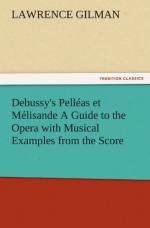One would have said, in advance of the event, that Debussy, of all composers, living or dead, was best fitted to write music for Maeterlinck’s beautiful and perturbing play. He was not only best fitted, he was ideally fitted; in listening to this music one catches oneself imagining that it and the drama issued from the same brain. It is impossible to conceive of the play wedded to any other music, and it is difficult, indeed, after knowing the work in its lyric form, to think of it apart from its tonal commentary. For Debussy has caught and re-uttered, with almost incredible similitude, the precise poetic accent of the dramatist. He has found poignant and absolute analogies for its veiled and obsessing loveliness, its ineffable sadness, the strange and fate-burdened atmosphere in which it is steeped—these things have here attained a new voice and tangibility.
In calling this a “revolutionary” score one is being simply and baldly literal. To realize the justness of the epithet, one has only to speculate upon what Wagner would have said, or what Richard Strauss may think, of an opera (let us adhere, for convenience, to an accommodating if inaccurate term) written for the voices, from beginning to end, in a kind of recitative which is virtually a chant; an opera in which there is no vocal melody whatsoever, and comparatively little symphonie development of themes in the orchestra; in which an enigmatic and wholly eccentric system of harmony is exploited; in which there are scarcely more than a dozen fortissimo passages in the course of five acts; in which, for the greater part of the time, the orchestra employed is the orchestra of Mozart,—surely, this is something new in modern musico-dramatic art; surely, it requires some courage, or an indifference amounting to courage, to write thus in a day when the plangent and complex orchestra of the Ring is considered inadequate, and the 113 instrumentalists of Salome, like the trumpeters of an elder time, are storming the operatic ramparts of two continents.




